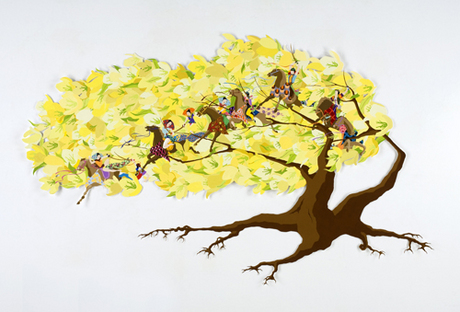This is an archive of the ArtCat Zine, 2007-2009. Please visit our new project, IDIOM.
Casey Ruble at Foley Gallery

Except in Struggle
Casey Ruble
Foley Gallery - 547 W. 27th St, New York NY
14 October - 15 November 2008
Despite a shortening of Marinetti's "except in struggle there is no more beauty," for a title and its consistent battle theme, Casey Ruble's solo show now on view at the Foley gallery is an entirely pacific, even pleasing presentation. Working equally well as a traditional gallery-style showcase and as a gently confident conceptual narrative, Except in Struggle is an extremely strong debut.
Ruble works in oversize paper cutouts of painstaking detail and complexity; setting images of Japanese warriors locked in densely patterned, rhythmic combat against the classic wuxia battlefields of trees and waterfalls. In three oversize pieces, these cutouts are simply affixed to the wall, giving them a delightful, provisional quality that highlights the delicacy of their craftsmanship. What is so striking is Ruble's ability to combine an almost industrial iteration with the natural movement of her settings. Warriors move though trees like leaves, or tumble down a waterfall in waves, but do so with all the suggestive uniformity of an assembly line. Conflict is here written into the natural fabric, an almost disturbing, steadfast refusal of that typical solacing conceit which labels any and all human agonism somehow artificial, unnatural, as though napalm were made on Mars.
This sort of reverse alienation effect is further muted by several smaller formal studies that hang opposite the larger, more densely imbricate works. These are technically abstractions of Japanese crests that have been layered over one another, a sort of whimsically literal symbolic combat. Considered contextually however -- with the warriors in the larger pieces costumed frequently in patterns "derive(d) from sources including Islamic architecture, Art Nouveau designs, Chinese lattices, and 1960s op-art geometries…" to name only those cited in the press release -- the smaller, framed studies almost seem a highly stylized model or seed, an earlier, as yet unpacked instantiation of the larger pieces. These works, in turn, appear as exploded; the smaller sorties translated and expanded: an exquisite grafting of post-Fordist international eclecticism onto some determinately impoverished Western samurai fetish. It's Robert Wilson directing the Rockette's production of Crouching Tiger, Hidden Dragon, and it's fantastic.
Which is the other thing, at the risk of sounding gauche, Ruble's in the first work in years that I actually wanted to own. It's a strange sensation; a slow, unwinding feeling of being at home in front of a piece. Quite frankly, I almost never have it. Usually if a work is good it is precisely the opposite feeling, namely that it should be on public display or not at all. But with Except in Struggle I had that adolescent urge to hoard, and I was suddenly reminded of being, technically, in a store. I like to consider myself pretty well inoculated against the temptations of the commodity, so I offer this, I think, as further evidence of these works' distinct beauty. Beauty being, in aughtie-eight, that sort of decidedly self-interested, particular, inessential and yet purposive quality that has become the ephemeral engine of high-end commerce; the casual grip of well-tempered merchandise. It's a hateful feeling, appearing only when confronted with things we absolutely adore.
ZINE
HOME
TIPS / COMMENTS
CATEGORIES
CONTRIBUTORS
- Greg Afinogenov
- B. Blagojevic
- Adda Birnir
- Susannah Edelbaum
- Julie Fishkin
- Paddy Johnson
- Jessica Loudis
- Christopher Reiger
- Andrew Robinson
- Peter J. Russo
- Blythe Sheldon
- S.C.Squibb
- Hrag Vartanian
